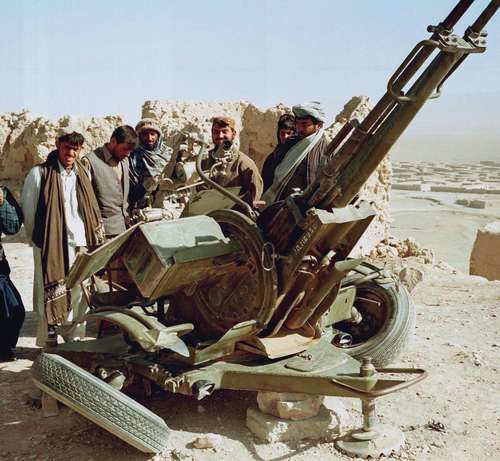|
|
|
The ZPU-1 and the ZU-23-2 (pictured) have seen a robust role in Afghan combat since the 1980s. |
On Oct. 28, a targeted ISAF airstrike killed Mullah Abdullah Kakar, one of the Taliban’s operational commanders in Zabul province who was responsible for a long list of attacks and IEDs in the Shah Joy district. What is interesting are the claims that Abdullah was killed as he showed off “a newly acquired anti-aircraft (AA) heavy machine gun which was mounted on the back of his vehicle” to other Taliban fighters. Although the AA platform was not identified, it was likely a ZPU-1 14.5 mm or ZU-23-2 heavy machine gun system that is able to kill low-flying helicopters and cause significant damage when used in ground-to-ground applications.
Last year, ISAF took out four such systems in a one-month period in Helmand province alone, several of which were going to be used in a multi-pronged assault against Lashkar Gah, the provincial capital. One of the systems was mounted on the back of pickup truck (a modified version that weighs less than 900 lbs.) and was being test-fired by Taliban gunners when it was destroyed. The increase in heavy weaponry and the ongoing desire to cause “sensational” headlines by downing Coalition aircraft remains a high priority for the Afghan Taliban.
Last week, the Washington Examiner published a report citing US intelligence officials who stated that Iranian military advisers are training Afghan insurgents to properly use anti-aircraft systems that are more sophisticated than the simplistic 14.5mm AA systems, namely the HN-5 and SA-7 shoulder-fired systems. Iran has also been accused in Afghan intelligence reports of supplying batteries for the older model surface-to-air missiles, according to the Washington Examiner.
While Afghan insurgents have long been known to receive training and lethal aid from clandestine networks overseen by Iran’s al Qods force, the Taliban have also been known to acquire rudimentary anti-aircraft platforms such as the HN-5; and the Taliban even unsuccessfully deployed them against Coalition aircraft in 2007. It should be noted, however, that the Taliban succeeded in downing several Coalition aircraft in 2009, four of which were in the Sangin District of Helmand province, and one of which was allegedly struck by a truck-mounted ZPU-1.
Although the Taliban and other Afghan insurgent groups may have acquired MANPADS platforms, or are least intending to increase their usage of even more low-tech platforms such as the truck-mounted ZPU-1/ ZU-23-2’s or luring Coalition aircraft into “RPG nets,” sophisticated systems are not yet widely deployed among Afghan insurgents. For instance, China also has another type or MANPAD other than the HN-5 available on the global market, the Qian Wei-1 (QW-1) MANPADS, reportedly similar to that used in the (US) Raytheon Missile Systems FIM-92 Stinger and (USSR/Russia) Igla systems. Pakistan has also been the beneficiary of the Chinese weapons market and has built a missile that is similar in appearance and performance to the QW-1 Vanguard, known as Anza Mark II. Given the nature of Pakistan’s overt facilitation, support, and protection of the Taliban’s senior leadership and the al Qaeda-linked Haqqani Network, such systems could certainly find their way onto the Afghan battlefield.
Are you a dedicated reader of FDD's Long War Journal? Has our research benefitted you or your team over the years? Support our independent reporting and analysis today by considering a one-time or monthly donation. Thanks for reading! You can make a tax-deductible donation here.









4 Comments
“Given the nature of Pakistan’s overt facilitation, support and protection of the Taliban’s senior leadership and the al Qaeda linked Haqqani Network; such systems could certainly find their way onto the Afghan battlefield.”
So why are we providing the Pakistanis $2B in military aid? (Unless, of course, the weapons that we give them have homing devices embedded in them… 🙂 The next time China squawks about defensive arms to Taiwan, we can remind them about their selling weapons-of-offense to the Taliban.
All the potential suppliers, except Iran, have had major problems with the terrorists or their allies. This makes it unlikely that Pakistan or China would be ready supplier of MANPADs (though who knows about the ISI). They just could not be sure which way they would be pointing.
The ISI is the best ranked intelligence agency in the world. They could be doing a whole bunch of things we have no idea about.
The problem with us is that we spend too much on inefficient things. The very fact that the ISI is far under-paid compared to the CIA, yet blows it out of the water in comparison to actual objectives achieved, really makes you think, do we have to start reviewing our military budget and slashing unnecessary things that get in the way?
The Dhsk weapons weren’t just for combat. They served as prestige weapons that proved that a given commander was well connected and were frequently shown off at shuras. The destruction of the weapons in Helmond were as much, perhaps more, of a blow to the insurgent’s psyche than their military capability.